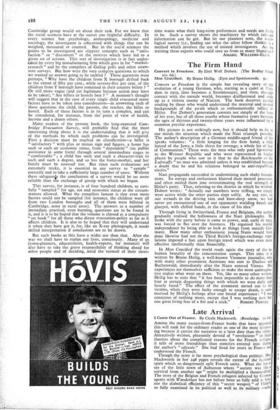Four Hundred Evacuees
The Cambridge Evacuation Survey. Edited by Susan Isaacs. (Methuen. 8s. 6d.) BILLETING-OFFICERS, teachers, housewives,' parents, children—an almost random sample from every pdrish—we have found our- selves in our thousands part of an enormous and partly conscious social experiment—the evacuation of school-children from danger-areas. For a long time we were so busy trying to get boots for Sam, underwear for Lily, something to clean up Gladys' hair, and a new billet for that Johnnie, that-we were only doll aware of wider implications. When we began to draw breath and to meet our colleagues, the wildest generalisations flew about; evacuees were " always," hostels were " always," billets were " always." Soon, some of us (used in other fields tp a rather more exact type of thinking) began to ask ourselves whether some of these sociologists could perhaps tell us something about what we had been doing—a few things, to reduce our speculation and flounderings to a few manageable hypotheses. For, in other fields at any rate, a nice bed of seedling hypotheses (given une and watering) can generally be trusted to produce in time the Fruits of Experience. Then we heard that in Cambridge, undo the supervision of a group of scrupulous psychologists and sociologists, a survey of evacuation was being made. Rum° said it was being made under difficulties. But we knew that of those most actively concerned with it was Susan Isaacs, and we, remembered her as almost the only educationist who had Ito experience in a progressive school (The Malting House) for the purpose of exact factual scientific observation, instead of simPlf for the benefit of a particular set of pupils.
Though full of hope, many of us were not quite clear how
Cambridge group would set about their task. For we knew that the social sciences have at the outset one frightful difficulty. In every science but psychology, anthropology, medicine and sociology, the investigator is cdncerned with things that can be weighed, measured or counted. But in the social sciences the points to be investigated are slippery concepts such as "satis- faction " or " discontent " or the motives which have led to a given set of actions. This sort of investigation is in fact under- taken by every big manufacturing firm which goes in for " market- research " and by the compilers of Gallup polls and other straw- vote surveys. But how were the very complex questions to which we wanted an answer going to be tackled ? These questions were perhaps, " Why have the children from X borough drifted back to the extent of fifty per cent., while seventy-five per cent. of the children from Y borough have remained in their country billets ? " Or still more vague (and yet legitimate because action may have to be taken), " Are billets or hostels best ? " A moment's thought will suggest that in the case of every single child evacuated many factors have to be taken into consideration—in answering each of these questions the child, the parents, the teacher, the billet or hostel. Each of these factors is in its turn a complex, and can be considered, for instance, from the' point of view of health, income and a dozen others.
Many readers of the present book, the long-expected Cam- bridge Evacuation Survey, will probably find that the most interesting thing about it is the understanding that it will give of the methods by which such problems can be investigated. First a decision must be reached on classification—a billet is " satisfactory " with plus or minus sign and figures, a home has such or such an economic status, from " dependent " (on public assistance in some form) through several intermediate stages to " comfortable " ; a child has such and such a character-trait to such and such a degree, and so has the foster-mother, and her family must be assessed too. But since such evaluations are extremely tricky, it is essential in any survey to " sample " correctly and to take a sufficiently large number of cases. Without these safeguards the conclusions of a survey would be no more reliable than the exchange of gossip with which we began.
This survey, for instance, is of four hundred children, as care- fully " sampled " for age, sex and economic status as the circum- stances allowed. What the compilers lament is that even more factors could not be sampled (for instance, the children were all from two London boroughs and all of them were billeted in Cambridge, none in rural areas). The answers to a number of immediate practical, even burning, questions are to be found in it, and it is to be hoped that the volume is classed as a compulsory " set book " for all those who direct evacuation-policy as far as it affects children. It is also to be hoped that they will understand it when they have got it, for, like an X-ray photograph, it needs skilled interpretation if conclusions are to be drawn.
But such books as this have a wider use than that. After the war we shall have to replan our lives, consciously. Many of us (town-planners, educationists, health-experts, for instance) will also have to take the grave responsibility of thinking ahead for other people and of deciding, amid the turmoil of their short-
time wants what their long-term preferences and needs are likely to be. Such a survey shows the machinery by which relevant information can be got. But let our planners note, the socio- logical survey (i e, finding out what the other fellow thinks) is a method which involves the use of trained investigators. Are we training these experts who could save us from so many blunders ?
AMABEL WILLIAMS-ELLIS.



























 Previous page
Previous page